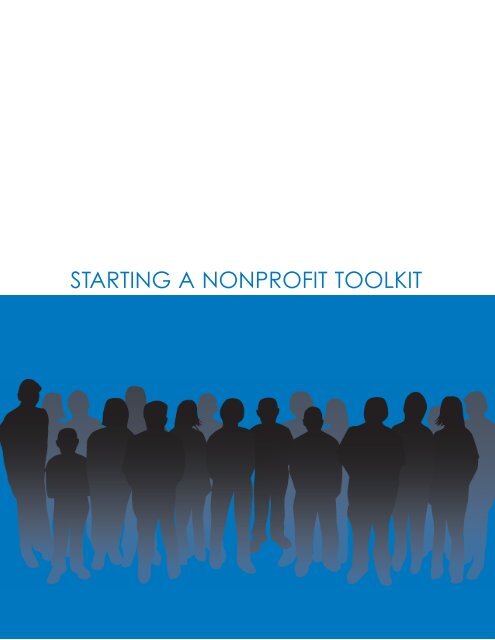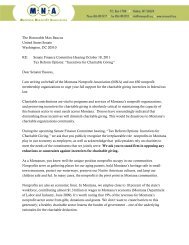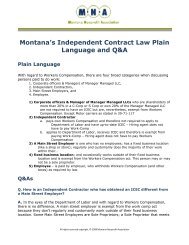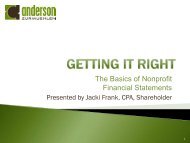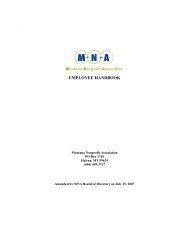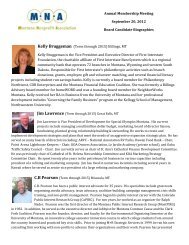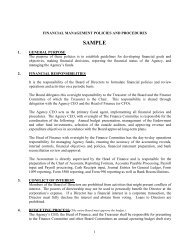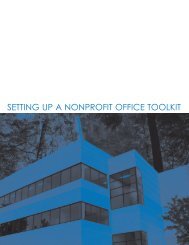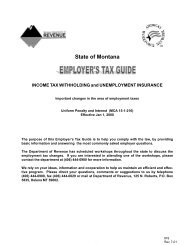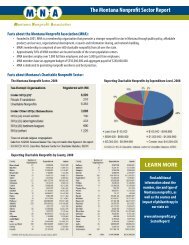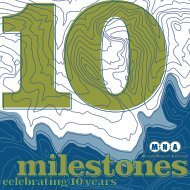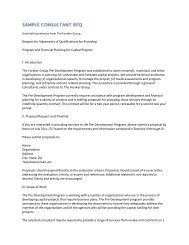Starting a Nonprofit Tool Kit - Montana Nonprofit Association
Starting a Nonprofit Tool Kit - Montana Nonprofit Association
Starting a Nonprofit Tool Kit - Montana Nonprofit Association
- No tags were found...
You also want an ePaper? Increase the reach of your titles
YUMPU automatically turns print PDFs into web optimized ePapers that Google loves.
STARTING A NONPROFIT TOOLKIT
<strong>Starting</strong> a <strong>Nonprofit</strong> <strong>Tool</strong>kitWelcome to the <strong>Starting</strong> a <strong>Nonprofit</strong> <strong>Tool</strong>kit! This practical toolkit will provide youspecific steps you need to start your own nonprofit organization as well as resourcesand links to help you during this process.In developing this kit, I compiled resources and tips that I use consulting to manystart-up nonprofits.This toolkit will cover the steps to starting a nonprofit organization in any stateincluding.1. Fiscal Sponsorship2. Steps to Incorporationa. Create Business Planb. Draft Mission Statementc. Recruit Board Membersd. Get a Lawyere. Draft Articles of Incorporationf. Draft Bylawsg. Apply for Business Nameh. Apply for Federal EIN#i. File Incorporation with Statej. Apply for Federal Tax-Exempt Statusk. Apply for Right to Solicit Donations3. Response from the IRSa. Advanced Rulingb. Public Support TestFollowing these steps and utilizing these resources will help you through a smoothincorporation process.Sincerely,Heather CarpenterM.M. <strong>Nonprofit</strong> Administrationheathercarpenter@nonprofitalternatives.orghttp://www.nonprofitalternatives.orghttp://www.nonprofitleadership601.blogspot.com1
<strong>Nonprofit</strong>s are tax exempt under the 501c status of the Internal Revenue Service.There are two types of nonprofits that fall under the 501c3 status--Public Charitiesand Private Foundations. The majority of people who start their own nonprofit applyfor 501c3 tax status which allows their nonprofit to receive tax deductible donationsand not pay taxes. There are two options to start your own nonprofit organization.One option is try to find another 501c3 nonprofit to fiscally sponsor your organizationor just take the steps to apply for 501c3 status.1. Fiscal SponsorshipFiscal Sponsorship is an option an organization can choose to follow before becomingan official 501c3 nonprofit. Fiscal sponsorship is good for individuals or groups in ahurry to begin operations and accept tax-deductible donations. However, manyfunding sources-foundation will not fund brand new groups.Fiscal sponsorship usually involves a contractual agreement between a sponsoringorganization and the organization being fiscally sponsored also known as the fiscalproject. Fiscal Sponsorship gives the fiscal project’s donors an opportunity to receivetax deductions for the donations that they provide for program support. In manycases the fiscal sponsor organization makes specific requirements for an organizationto be fiscally sponsored. Some of these requirements involve the fiscal project toengage in strategic planning, fiscal reporting, and accountability activities. There aremany ways an organization can be fiscally sponsored, for example one organizationcan be a project of another organization, or the fiscal project is separate entity witha Board of Directors. “Fiscal Sponsorship: 6 Ways To Do It Right,” by Gregory L.Colvin, goes into more details about the different types of fiscal sponsorship.It is helpful if new organizations that are looking for a fiscal sponsor do a littleresearch before they jump into a fiscal sponsorship relationship. This really helpsduring the contract negotiation. Since the IRS is really particular about how fiscalsponsor relationships are set up there are a lot of rules about ownership of funds, forexample in most cases the new organization doesn’t have any control over themoney that the donors give to the fiscal sponsor. So, it is challenging when neworganizations add clauses in the contract to try to control their funds. It is helpful ifnew organizations not only learn about the benefits of being fiscally sponsored butalso the limitations to being fiscally sponsored. However, once a new organization isfiscally sponsored they can generate donations and funds until they are ready toseparate from their fiscal sponsor and apply for 501c3 nonprofit status.The Foundation Center has a great fiscal sponsorship tutorial for anyone interested inlearning more about fiscal sponsorship and the Community Resource Center inColorado also has a great step-by-step explanation about fiscal sponsorship and thedifference between the term "fiscal agent" and "fiscal sponsor." www.Capaciteria.orgprovides a list of organizations that provide fiscal sponsorship.2
2. Steps to IncorporationThere a 10 specific steps to create an official 501c3 nonprofit organization. I willexplain each of these steps briefly, however I highly recommend reading Nolo Press’sbook: “How to Form a <strong>Nonprofit</strong> Corporation” which describes each of theseincorporation steps in great detail as well as provides sample forms and templatesthat nonprofits need for incorporation. Some of these documents and templates canalso be found on the National Economic and Development Law Center’s website, see<strong>Nonprofit</strong> Corporation and Formation:http://www.nedlc.org/Publications/publications_legal.htm as well as the IRS website.The steps to incorporation.a. Draft Business PlanA nonprofit is like any business and requires a good plan to get started.Sample plans can be found on the Small Business Administration’s websitehttp://www.sba.gov. A good plan includes these components:• Mission statement• Description of activities• Marketing plan• Need for your nonprofit in the community, evaluation of what is alreadyout there.• Board and Staff bios showing their capabilities to perform the duties of thenonprofit.• 3 year budget including realistic income and expenses. Some of theseexpenses are:ooooooStart-Up CostsPre-incorporation expensesIncorporation & filing fees, board recruitmentOffice, furniture, equipment, legal, accounting, marketing, logo,technologyInitial Operating costsRecruitment & Training, insurance, postage, and utilitiesb. Draft Mission StatementYour mission statement states what you do and why, short and to the point,convey passion. A mission statement is usually accompanied by a visionstatement which shows where your organization wants to accomplish in thefuture.c. Recruit Board MembersYou are required to have a minimum of 3 board members to start. Recruitpeople you can trust. It is important to be diverse in board member selection.While some board members may be able to give money, others may haveexpertise in an area that is needed. As an example, if an organization isrecruiting 9 board members, it will want to recruit a lawyer, a teacher, anentrepreneur, two constituents (someone who benefits from the3
organization’s services), a local community leader, a businessperson, amember of the nonprofit community, and a psychologist. The board memberresource center is: http://www.boardsource.org. Board source also providesaffordable how-to guides for board members. The Council on Quality andLeadership also provides a free guide called, “Developing and Supporting aBoard of Directors.” http://www.thecouncil.org.In some states the Board Chair and the Board Secretary cannot be the sameperson.d. Get a LawyerIt is not a requirement for nonprofits to use a lawyer during the incorporationprocess; however it is helpful to receive legal advice from the start. In somecities and states, start-up nonprofits can receive pro-bono legal advice fromtheir local bar association or other legal services organization.e. Draft Articles of Incorporation• Must be a tax-exempt purpose• No profits can benefit any individual• Cannot be a political organization• Upon dissolution, all assets must go to another tax-exempt organization ofsimilar servicef. Draft BylawsThe bylaws are a very important document for a new nonprofit. <strong>Nonprofit</strong>smust follow what is stated in their organizational bylaws so it is important towork with trusted board members and advisors when creating the bylaws foryour organization. The bylaws describe your organization’s corporate rules,behaviors, and actions and include the following sections:• Powers of the board• Meetings information• Directors (numbers, elections, tenure, vacancies, removal, quorum,compensation, voting)• Officers• Committees• Operational Staff• Fiscal Year• Conflicts of Interest• Amendmentsg. Apply for Business NameApplying for a business name is another important step in the incorporationprocess. Check on www.Guidestar.org to see if name isn’t already being usedby a nonprofit. Think twice about including Foundation in the name of yourorganization because many assume foundations already have endowed orexisting funds. Names are approved on a state by state basis; however somenonprofits choose to also trademark their name to avoid potential future law4
suites. Here are the requirements for applying for a name with the Secretaryof State.• Name must not already being used in the state• Name availability search with Secretary of State• Reserve name with Secretary of Stateh. Apply for Federal EIN#• National application SS-4 with IRS.• This is a permanent identity for all government reports and documents.i. File Incorporation with State<strong>Nonprofit</strong> status requirements vary from state to state, however many statesprovide nonprofits with exemption from sales tax. In addition, each state’sAttorney General and Secretary of State’s website list nonprofit specific filingrequirements. It is also helpful to consult a nonprofit attorney to find out thespecific state filing requirements.California requires nonprofits to fill out form 3500 Franchise Tax Exemptionapplication. Additional documents required with this application are:• Financial Statements/Budget• Articles of incorporation• Bylaws• Supporting Documents including statement of activitiesj. Apply for Federal Tax-Exempt Status• Form 1023• You will also need to include the minutes of first board meeting• Most nonprofits can also apply for sales tax exemption; however this isnot the case in the state of California.k. Apply for Right to Solicit DonationsThis is done with your state’s Attorney General’s office and is an annual filingrequirement.5
Response from the IRSOnce you submit all your paperwork to the IRS it generally takes between 8-12months to receive a response. While your application is pending, you may startreceiving tax-deductible donations, however nonprofits be cautious because if theirapplication is not approved then they are required to return the money from theirdonors.Public Support TestIn order to be considered a 501c3 public charity, nonprofits must prove they are apublic charity by following a public support test. This means over a five year periodmore than 2/3rds of their funds must come from a variety of sources. Generallynonprofits that have been fiscally sponsored can pass the public support test,however new organizations that don’t have very much funding or funding from justtwo sources may not be granted permanent 501c3 status. The public support testinformation is included in the 1023 IRS exemption application.Advanced RulingFor those organizations that cannot pass the public support may be awarded anadvance ruling period. This is a five-year period gives nonprofit an opportunity to getdonations from a variety of sources. For more information about the advanced rulingperiod check out information on the IRS’s website. <strong>Nonprofit</strong>s should carefully tracktheir funding during this advanced ruling period and work to receive donations froma variety of public sources.http://www.irs.gov/charities/charitable/article/0,,id=123155,00.html6
About the AuthorHeather has served as Operations Manager, Consultant, Speaker and Trainer tononprofit organizations in California and Illinois for over 6 years. She earned herMasters of Management in <strong>Nonprofit</strong> Administration from North Park University inChicago, Illinois. Heather is currently pursuing her PhD in Leadership at theUniversity of San Diego. Heather is creator and author of the <strong>Nonprofit</strong> Managementand Operations blog and was interviewed by the national women's blogging website—Blogher; quoted as being a, “<strong>Nonprofit</strong> Operations Guru.” Heather is currentlyblogging about <strong>Nonprofit</strong> Leadership at her <strong>Nonprofit</strong> Leadership 601 blog.DisclaimerHeather is not getting paid by the particular companies or consultants to providerecommendations. The resources listed in the toolkit Heather has found helpful instarting a nonprofit organization. This information is provided strictly for educationalpurposes.Many of these resources will be helpful to you and others may not be helpful.Feedback is always appreciated, so any suggestions or comments on how to makethis toolkit more helpful to future clients would be much appreciated.This document is Creative Commons Attribution-Noncommercial-Share Alike 2.5License.7
Are you are really passionate about an issue and thinking about starting your own nonprofit--butdon’t know where to begin? This toolkit provides a simple overview as well as practical resourcesfor starting your own nonprofit organization. The toolkit is broken into three key areas that areimportant to know before starting any nonprofit organization. These areas include: fiscal sponsorship,key steps to 501c3 nonprofit incorporation, and handling responses from the IRS.The toolkit also includes information about the IRS’s Five-Year Advance Ruling Period and steps youcan take during that period to insure your nonprofit’s public charity status.This practical information will help you through a smooth incorporation process.Heather is passionate about your nonprofit’s operations!! She has served as an Assistant Director,Operations Manager, Consultant, Speaker and Trainer to nonprofit organizations in California andIllinois for over 6 years. She earned her Masters of Management in <strong>Nonprofit</strong> Administration fromNorth Park University in Chicago, Illinois and is currently pursuing her PhD in Leadership at theUniversity of San Diego. Heather is creator and author of the <strong>Nonprofit</strong> Management and Operationsblog and was interviewed by the national women’s Blogging website—Blogher which quoted her asbeing a “<strong>Nonprofit</strong> Operations Guru. ”Heather currently blogs about <strong>Nonprofit</strong> Leadership at her<strong>Nonprofit</strong> Leadership 601 on Blogspot.com.www.nonprofitalternatives.orghttp://nonprofitleadership601.blogspot.com


